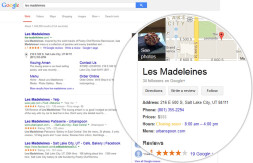Natural vs. Augmented: What Does Google Penguin Prefer?

No, we’re not talking about the adorable flightless bird. If you’re not familiar with Penguin, this is the name of the algorithm update that Google began rolling out in May of 2012. It’s primarily targeted to affect websites that employ SEO techniques which break Google’s quality guidelines. Why should you care about this technical jargon? Because as an online merchant, these changes that have been going on behind the scenes at Google are having a massive impact on the way Google is ranking your business in its organic search results, and it has a big trickle down affect in the way your competitors are positioning themselves against you. We’re going to focus this article on some important changes related to backlink anchor text in the Penguin update.
What is backlink anchor text?
Backlink Anchor Text is the visible text used in hyperlinks on outside web pages that point back to your website, or a particular webpage. (In the previous sentence, “your website” is backlink anchor text for www.nexternal.com). It is one of the many things used to determine search engine rankings. Just a year ago, one of the strategies SEO firms could successfully employ to increase your Google rankings, was to identify a few keywords or long tail key-phrases, and go out around the internet, building a ton of backlinks with exact anchor text linking back to your site. Perhaps you have a makeup site, and in doing keyword research, they found that “Buy organic lipstick” was a popular keyword phrase with good search traffic that would work well for your products. They could use article marketing, guest blog posting, blog commenting, directory postings, etc. to create links pointing back to your site. They would include the anchor text of your keyword phrase, “Buy Organic Lipstick” when they posted their articles and blog comments. This was a great strategy that worked! The more links coming to your site, pointing with that EXACT text, the better you would fare on Google searches! But times have changed, and what may have worked just last year to get you onto page one in certain searches, doesn’t work for you this year.
Google’s Penguin update has specifically zoned in on backlink anchor text it deems suspicious. If all of your backlink anchor text is exactly the same, it looks to Google to be less organic and authentic, and appears to be more the result of strategic SEO practices, rather than authentic links from individual around the internet. What are the odds that 90% of the websites that are linking to you would really use the exact term, “buy organic lipstick” as their anchor text? Authentic backlinks from various individuals would use a mix of links. You would likely see quite a few “click here” anchor texts, and other variations of anchor text incorporating synonyms, such as “best makeup”, or “get natural cosmetics”, or “my favorite natural lipstick”, etc. All of these terms are related, and they look more natural.
What backlink anchors are you looking for?
Google wants to see a mix of inbound links which look natural. From what we gather, and from what the SEO experts say, sites are performing well on Google who have exact match keyword phrases in fewer than 20% of their inbound links. Alternative styles of anchor text could include Brand name links (such as Nexternal), branded links (such as (Nexternal eCommerce Platform), URL (such as www.nexternal.com), keyword phrases (such as shopping cart software by Nexternal), other phrases (such as the best shopping cart software), and others (such as start a free trial). SEOMoz lays out a recommended ratio for each of the above styles of anchor text, based on some exhaustive research they conducted.
How do you check your backlink anchor text?
If you did your own backlink building work, you hopefully remember your own techniques! If you hired an SEO firm at some point to increase your page ranking, and one of the things they did was build backlinks, you should check out your backlinks. There are several tools out there that can allow you to do this. One such free source is in Google Webmaster Tools / Traffic/Links to Your Site/How Your Data is Linked. This shows you the anchor text being used most frequently to link into your site.
What can you do if you find you do have a backlink issue?
Since these are posted on external sites, you likely will not have access to the page in order to simply update the anchor text yourself. In some cases you may be able to contact the site owner, but don’t bet on them being motivated to make a change. Your best strategy is to build additional links to bring the ratio of your anchor text into a natural looking state. Be sure to be very cognizant of anchor text and to vary it when you submit press releases that link back to your site, if someone is writing a post on their blog about you, if you are guest posting, etc. Most of the time you don’t have control over backlink anchor text, but when you do, use variations that seem natural.
This summer, Google is looking forward to rolling out additional Penguin changes, known as “Penguin 2.0”, but the changes that have been publicly discussed by Google’s Matt Cutts haven’t hinted at any additional scrutiny of backlink anchor text.














